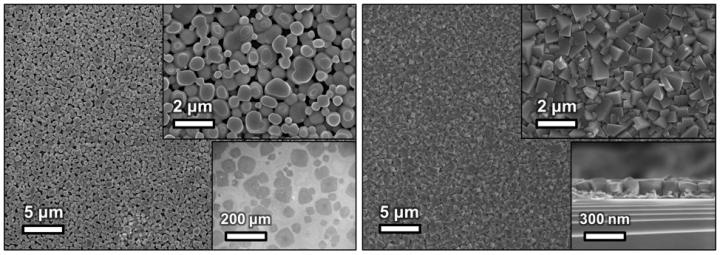May 24 2017
A new method that allows obtaining highly crystalline organic-inorganic perovskite films for solar cells has been elaborated by members of the Laboratory of New Materials for Solar Energetics, working at the Faculty of Material Sciences. In association with their colleagues from the Faculty of Chemistry of the Lomonosov Moscow State University. The findings of this project are published in the Materials Horizons.
 These are microphotos of perovskite films of various morphology obtained by the elaborated technique. CREDIT Alexey Tarasov
These are microphotos of perovskite films of various morphology obtained by the elaborated technique. CREDIT Alexey Tarasov
Scientists of the Lomonosov Moscow State University Press Service have previously worked on nanowires of hybrid organic-inorganic perovskites, which are considered to be a promising substance for developing light emitting diodes, photodetectors and lasers on their basis. The most promising application area for such substances is elaboration of perovskite solar cells- namely, photovoltaic devices of new generation. Over the last five years, the efficiency of these devices has increased by several times and presently comprises even more than 22%. This seems to be majorly higher when compared to the maximum efficiency, attained for solar cells on the basis of polycrystalline silicon. The most popular solar cells, manufactured industrially, have an efficiency of 12-15%.
Currently, it is possible to distinguish two key approaches to obtain such a material. The first approach involves coating with chemical agents from vaporous state and the second implies solution crystallization. In the recent years, projects that focus on enhancing these methods have experienced intensive development. Thus, the elaboration of new techniques for developing materials, employed in photovoltaics, could provide new impetus in the area development.
As part of the study we've found out several new compounds -- polyiodides, which are liquid at room temperature, possessing unique properties. They look like viscous liquids of dark brown color with metal gleam, obtained from two solid powders, which simply melt while blending. Liquid state of such compounds allows not to use hazard solvents and, moreover, their chemical composition contributes to formation of a necessary perovskite upon contact with a metallic lead film or other lead compounds. As a result of the chemical interaction between a lead film and polyiodide melts, a perovskite film, comprised of large interpenetrating crystals, is formed.
Alexey Tarasov, Doctor of Chemistry, Head of the Laboratory
A spin coating technique allows polyiodide melts to be deposited on lead. For this purpose a glass substrate, on which a lead layer is applied by thermal spraying, is fixed on a whirling rod and starts rotating. Polyiodide is applied on the whirling glass substrate and then polyiodide residue is flushed by a solvent called isopropanol. This results in obtaining perovskite films from 200 to 700 nm in thickness. Their stability is determined, for the first place by the material, of which they consist. The members of the Faculty of Material Sciences have established the possibility of diversifying the composition of applied polyiodides and have also pointed out the possibility to select a composition with optimal stability.
A perovskite film exhibit intense photoluminescence and large lifetimes of charge carriers that provides good functional properties. We've also revealed in our project the possibility to obtain perovskite films of various compositions, while using mixed polyiodide compounds. Researches, conducted by our laboratory in the area of perovskite photovoltaics, are funded in the framework of a Federal Target Program of the Russian Ministry of Education and Science together with the industrial partner - EuroSibEnergo Company.
Alexey Tarasov, Doctor of Chemistry, the Head of the Laboratory and the Study Lead shares
Currently, the Laboratory continues to study the properties of discovered polyiodides and also elaborates on their basis a technology, which enables obtaining high-efficiency solar cells.